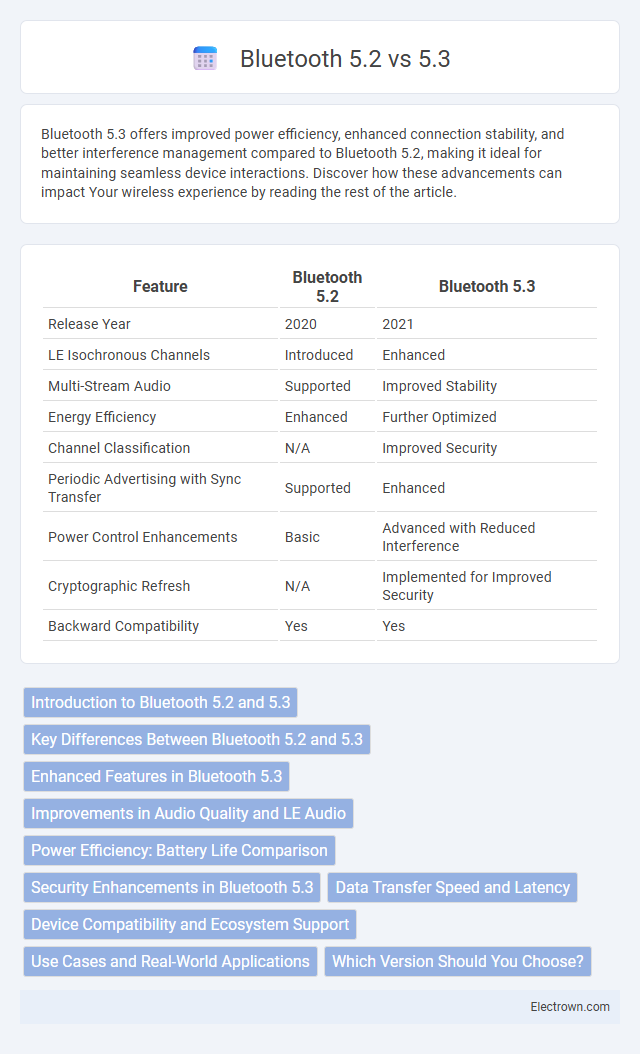Bluetooth 5.3 offers improved power efficiency, enhanced connection stability, and better interference management compared to Bluetooth 5.2, making it ideal for maintaining seamless device interactions. Discover how these advancements can impact Your wireless experience by reading the rest of the article.
Table of Comparison
| Feature | Bluetooth 5.2 | Bluetooth 5.3 |
|---|---|---|
| Release Year | 2020 | 2021 |
| LE Isochronous Channels | Introduced | Enhanced |
| Multi-Stream Audio | Supported | Improved Stability |
| Energy Efficiency | Enhanced | Further Optimized |
| Channel Classification | N/A | Improved Security |
| Periodic Advertising with Sync Transfer | Supported | Enhanced |
| Power Control Enhancements | Basic | Advanced with Reduced Interference |
| Cryptographic Refresh | N/A | Implemented for Improved Security |
| Backward Compatibility | Yes | Yes |
Introduction to Bluetooth 5.2 and 5.3
Bluetooth 5.2 introduced features like Isochronous Channels for enhanced audio solutions and LE Audio support, significantly improving power efficiency and audio quality in wireless devices. Bluetooth 5.3 builds on these advancements by offering improvements in periodic advertising with sync transfer, enhanced connection subrating, and better power control to optimize performance and battery life. Your devices with Bluetooth 5.3 will benefit from more reliable connections and reduced energy consumption compared to those using Bluetooth 5.2.
Key Differences Between Bluetooth 5.2 and 5.3
Bluetooth 5.3 introduces enhancements over Bluetooth 5.2, including improved power efficiency through Isochronous Channel feature updates and Advanced Encryption standard optimizations, which increase security without compromising performance. Bluetooth 5.3 also offers better slot availability mask (SAM) management, enabling more reliable data transmission and reduced interference in congested environments. Your devices benefit from these upgrades with enhanced connectivity stability, lower latency, and extended battery life.
Enhanced Features in Bluetooth 5.3
Bluetooth 5.3 introduces enhanced features such as Isochronous Channels, improving support for LE Audio by enabling synchronized audio streams to multiple devices, which is not available in Bluetooth 5.2. The new Bluetooth 5.3 specification also includes improvements in power efficiency with Periodic Advertising Enhancement and Channel Classification Enhancement, leading to extended battery life in connected devices. These advancements optimize wireless audio experiences and device connectivity, marking a significant upgrade over Bluetooth 5.2 technology.
Improvements in Audio Quality and LE Audio
Bluetooth 5.3 offers enhanced audio quality through improved Low Energy (LE) Audio features, including support for Multi-Stream Audio, which provides synchronized sound across multiple devices for better stereo separation and reduced latency. Compared to Bluetooth 5.2, Bluetooth 5.3 introduces Isochronous Channels with enhanced efficiency, enabling more stable and synchronized audio transmission in hearing aids and true wireless earbuds. These improvements result in a richer listening experience and extended device battery life by optimizing data transmission protocols within the LE Audio framework.
Power Efficiency: Battery Life Comparison
Bluetooth 5.3 improves power efficiency over Bluetooth 5.2 by introducing enhanced Isochronous Channel management and improved scheduling, resulting in reduced latency and lower energy consumption during data transmission. Devices using Bluetooth 5.3 demonstrate longer battery life through optimized power control features and better management of Idle and Active states. In practical terms, Bluetooth 5.3-enabled gadgets can achieve up to 10-15% longer battery life compared to Bluetooth 5.2 counterparts under similar usage conditions.
Security Enhancements in Bluetooth 5.3
Bluetooth 5.3 introduces advanced security enhancements over Bluetooth 5.2, including improved encryption key management and more robust protection against passive eavesdropping and active attacks. The Enhanced Attribute Protocol (EATT) in Bluetooth 5.3 provides stronger data integrity and faster recovery from transmission errors, reducing vulnerabilities during communication. These upgrades make Bluetooth 5.3 a more secure standard for wireless connectivity in IoT devices, wearables, and smart home applications.
Data Transfer Speed and Latency
Bluetooth 5.3 offers improvements over Bluetooth 5.2 by enhancing data transfer speed and reducing latency through more efficient channel usage and better interference management. Your devices leveraging Bluetooth 5.3 experience faster and more stable connections, benefiting real-time applications like audio streaming and gaming. These optimizations result in smoother performance with lower power consumption compared to the previous 5.2 standard.
Device Compatibility and Ecosystem Support
Bluetooth 5.3 enhances device compatibility by introducing improved power control and enhanced advertising capabilities, allowing seamless integration across a broader range of devices compared to Bluetooth 5.2. Ecosystem support for Bluetooth 5.3 is rapidly expanding, benefiting from backward compatibility with earlier versions while enabling developers to leverage advanced features for smarter interoperability. This makes Bluetooth 5.3 a more future-proof choice for devices requiring robust connectivity within diverse wireless ecosystems.
Use Cases and Real-World Applications
Bluetooth 5.3 boasts enhanced energy efficiency and improved connection stability compared to Bluetooth 5.2, making it ideal for smart home devices, wearable technology, and medical applications requiring reliable, low-latency communication. Bluetooth 5.2 introduced Isochronous Channels, enabling better support for LE Audio and synchronized multi-device audio experiences, which enhance wireless headphones and hearing aid performance. Your choice between Bluetooth 5.2 and 5.3 will depend on whether you prioritize slightly improved power management and connection robustness or the versatility in audio streaming and device interoperability.
Which Version Should You Choose?
Bluetooth 5.3 offers enhanced energy efficiency, improved connection stability, and better interference management compared to Bluetooth 5.2, making it ideal for devices requiring longer battery life and reliable performance. Bluetooth 5.2 remains a strong choice for many applications, especially in existing ecosystems where compatibility and cost-efficiency are priorities. Choose Bluetooth 5.3 if your device demands cutting-edge features and future-proof connectivity, while Bluetooth 5.2 suits budget-conscious or backward-compatible implementations.
Bluetooth 5.2 vs 5.3 Infographic

 electrown.com
electrown.com